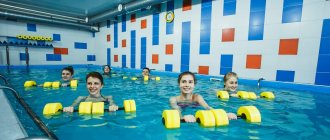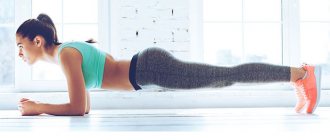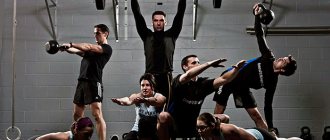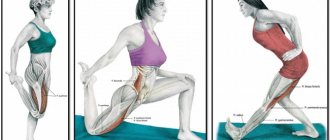Everyone knows that swimming brings enormous benefits to the human body. Even in Ancient Greece, swimming was an integral part of physical education, and since the 15th century, competitions in this sport were regularly held. Initially, swimmers trained and competed in natural reservoirs, but at the beginning of the 19th century, the construction of artificial pools began, and swimming began to actively gain popularity.
Today, swimming in the pool is one of the most popular ways to stay fit. However, before you go to the box office to buy a subscription, you need to clearly study all the pros and cons of swimming in the pool - this is the only way you can achieve the desired effect without harm to your health, in particular, lose excess weight, strengthen muscles or relieve nervous tension.
The benefits of swimming
While swimming, a person trains the respiratory and nervous system, heart, blood vessels and muscles, while relieving stress and emotional stress:
- When swimming, almost all muscle groups work. Which of them bear more load depends on the chosen style. For example, if you swim breaststroke, you train your hips, buttocks, and calves. The crawl is a balance - the load is distributed evenly. Depending on which body systems need to be influenced, different styles can be used during the exercise.
- This sport develops the chest and lungs. Swimmers are good at running long distances - they are resilient. They can easily cope with cross-country and not “suffocate”. Swimming is a prevention of pneumonia and a good way to recover from coronavirus. After all, the lungs are constantly training. This means they are able to resist diseases.
- In the process of swimming, flexibility develops. During training in the water you have to perform strokes, dives, and flips. The muscles stretch, the body becomes elastic.
- Joints and spine are strengthened. Swimming is the prevention of scoliosis, coxarthrosis and a number of other diseases of the back, including the lumbar region of the body, the musculoskeletal system, and the hip joints. In water, muscles both relax and strengthen. A reliable “corset” is formed, which prevents the vertebrae from shifting and the joints from becoming “loose.”
- Coordination and mobility develop. A body of water - a pool or the sea - is not space, but you can swim in different directions - on and under the water. The body constantly has to focus on how it is located in space.
- The psychological state improves. Visiting the swimming pool is also a method of dealing with stress. Water has a tactile effect on the body, calms it, and a signal of relaxation is transmitted to the brain.
- The restoration of muscles and joints is activated. With the help of a swimming pool you can recover from injuries. Swimming is not contraindicated even for disabled people. The water supports the body, there are no shock loads, but the muscles still tense. The recovery process is gradually underway.
- Swimming burns a large amount of calories. By doing this sport, you can lose weight.
There are many advantages. There are contraindications. They will be discussed further. For now, let’s dwell on the advantages of swimming for children, women and men.
For men
It is believed that men are most susceptible to developing cardiovascular diseases; they often have problems with blood pressure. Swimming helps to cope with this. The muscles work, the lungs are filled with oxygen, the blood circulates quickly, saturating the organs and tissues with useful substances and removing harmful substances from the body. Heart function and overall well-being improves.
Men are more likely than women to engage in sports that are dangerous in terms of injuries: hockey, martial arts, weightlifting. As stated, swimming is a useful activity for restoring the body: muscles, joints.
Swimmers have a beautiful body with a sculpted, toned stomach. You don’t even need to swing, just spend an hour in the pool three times a week. Swimming is already a workout.
Swimming helps to cope with purely male problems. We are talking about prostatitis, potency, etc. When the body is in water, it is massaged, which has a positive effect on the prostate gland of an adult man. Movement is also the prevention of prostatitis. And in the pool you won’t be able to “stand” in one place. Older men are advised to set aside time for swimming. After 50 years, as a rule, testosterone levels decrease, weakness appears, and the belly begins to grow. It's time to sign up for the pool to get yourself in order.
For women
Girls are usually most concerned about the problem of obesity and increased body weight. The pool helps solve it. The results will be noticeable after the first few workouts.
Even slender girls are recommended to go swimming, because participation in such sports contributes not only to weight loss. It is important that training in water allows you to keep the weights in the desired range. Losing extra pounds is not that difficult. The usefulness of swimming is that it helps keep the scales on the same numbers. Fat is lost in the process and calories are burned. And muscle mass increases. It can be adjusted. Let's list a few more advantages of swimming:
- Skin tightening. When a person swims, the body is massaged. This makes the epidermis elastic and beautiful.
- Fighting stress. It is believed that women are more susceptible to negative emotions. Exercising in water distracts you from bad thoughts, giving you positive energy.
- Getting rid of varicose veins. The female body is most susceptible to problems with veins. For prevention, you should go for a swim. Water massage improves blood circulation in the limbs. If you stay in the pool for 60-90 minutes three times a week, then the problem will not appear.
- Stimulation of the female genitourinary system. It is saturated with blood and, accordingly, oxygen. This is the prevention of diseases and improvement of reproductive function.
And there are contraindications for women. They will be discussed separately.
For children
The question immediately arises about how old a child must be before he can be taken to the pool. Pediatricians and sports trainers say that a baby can be put into water almost from birth. Babies are like dolphins. Nature itself teaches them to swim. From infancy, a child can flop around like a frog. This is still typical for a three-month-old human. As the baby gets older, he “forgets how” to swim. There's no point in leaving the pool. It will be necessary to develop a skill that is not associated with innate reflexes.
Preschoolers can master the basics and train individual elements. Classes should take place in the form of a game. When a child has left preschool age, he can be truly trained to work and strive for records. School-age children participate in competitions and then grow into adult champions.
However, swimming is not always about records. You can swim for pleasure and for health purposes. Teenagers like to go to the pool in groups when it is not possible to dive in open water - during the cold season. Therefore, there is no need to consider swimming solely as a sport. This is a hobby that improves your health and improves your mood.
The problem is that not everywhere there are places for swimming with kids. There are plenty of children's pools in cities. But they set age restrictions - few people want to work with infants. For example, it is difficult to go swimming with a toddler who is under 3 years old. Only large cities have such services.
Children are recommended to swim for the following reasons:
- Strengthening the immune system. In water, the body develops and develops the ability to resist viruses and bacteria. It is in childhood that you need to start strengthening your immune system. The earlier the better.
- Prevention of diseases of the musculoskeletal system. The swimming pool is an indication for people who have back problems. Scoliosis often develops in childhood. Because of riding a bicycle, playing computer games, sitting at a desk for a long time.
- Solution to sleep problems. Children have a lot of strength and energy, not like an adult; it is not always possible to waste it all during the day. Guys sometimes don't sleep well. The solution to the problem is simple: you need to enroll your son or daughter in the pool. Experience shows that after swimming, children fall asleep better. Swimming provides a large but gentle load on the muscles.
- Appetite stimulation. Children often eat poorly and go overboard with food. During training, a lot of calories are consumed, and eating behavior improves.
Swimming is beneficial for women, men and children. If there are no contraindications.
Swimming pool after workout
During intense exercise, the muscles work a lot and become very tense. This is work for the sake of a developed body. But there should be a time and place for relaxation. Good options:
- pool;
- sauna.
All this is available at the La Salute fitness club. Here, experienced instructors are always happy to help beginners master the basics of swimming and introduce children and adults to different styles.
Safety Tips
- The following tips will help reduce the risk of injury while swimming:
- Swimming is only necessary in areas designated for swimming, such as pools, fenced areas of lakes and other bodies of water supervised by lifeguards.
- If swimming is new, then you first need to take a few introductory lessons with a coach.
- When swimming outdoors, it is better to use sunscreen of 15 spf or higher to protect your skin.
- Be sure to constantly consume water, even if you don’t feel like drinking. Drinks with alcohol or caffeine should be avoided.
- Children must be supervised at all times. To avoid accidents, children should not be allowed to swim without supervision.
Contraindications and harm
Unfortunately, swimming in the pool can be harmful. Consider the potential negative impact:
- Possibility of being harmed due to poor water quality. Not all fitness centers use advanced cleaning systems, such as ozonation and ultraviolet treatment. Many people still use bleach. The substance is safe in small concentrations. But if there is a lot of it, then vision, breathing, and other body systems suffer.
- A common harmful factor is the risk of contracting a fungus. This is difficult to prevent. It is necessary to choose a good place for swimming, where the sanitary and epidemiological situation is closely monitored.
- The influence of too active a start. Many people sometimes begin to swim so zealously that they overload an unprepared body. This harms muscles and joints. You need to listen carefully to the trainer, increase the load gradually so that there are no negative consequences.
It is believed that by swimming, women can acquire a masculine figure: broad shoulders, narrow hips. This is typical only for professional swimmers. A few more contraindications for frequent use of the pool:
- infectious diseases;
- chronic health problems;
- skin disorders;
- increased body temperature;
- high fatigue;
- tuberculosis;
- diseases of the dermis;
- allergies - in some cases.
Separately, we note pregnancy and heart pathologies. It was stated above that swimming strengthens blood vessels and the muscle that pumps blood through itself. Heart disease is a contraindication if the doctor has prohibited exercise. The same applies to the spine, if there is a hernia, for example. Pregnant women can swim in the absence of pathologies.
In each specific case, the doctor must give permission to practice. Menstruation is not a contraindication. But it’s better not to go to training for the first days, and then you can use tampons. However, everything is individual.
Water
Water is the best “massage” for the male genital organs. Regular exercise in water has a positive effect on erectile dysfunction. If you swim every day for half an hour, there is a significant increase in libido.
Among other things, exercise has a positive effect on the functioning of the body as a whole. Therefore, it is worth delving into more detail in what cases swimming is irreplaceable and what happens after training.
Where to train
It is very important to choose the right pool. If you choose the wrong place, you won’t have fun, you’ll waste time, and in the worst case, you’ll catch an illness. The likelihood of contracting a fungus was mentioned above. The degree of compliance with sanitary and epidemiological standards must be taken into account. It’s good if the doctor at the pool requires a certificate of admission to visit the establishment. But this is not the only thing to consider. Some tips:
- Find out where there are swimming pools in your community.
- Find out if they are free to visit. For example, there are places only for students of a particular university and you cannot get there from the outside.
- Sign up for trial classes and evaluate everything on the spot: water quality, condition of the locker rooms, additional services - the presence of a sauna, a buffet. All the little things matter.
- Please note: the cost of visiting - there is no point in spending a lot, given the general equality, working hours - for some it is more convenient to study early in the morning, for others - late in the evening. You also need to evaluate the size of the pool. When there is no goal to break records, then, for example, 50 meters will be enough.
- Talk to a trainer if you plan to train individually. Read reviews about it. Ask about the instructor from those who are already training with him.
Our center offers individual lessons. Professionals help beginners get comfortable and achieve the desired results and goals.
Strengthening the immune system
Exercising in water hardens the body and helps develop protection against colds. They help in the fight against infections, allow you to easily tolerate physical activity and sudden changes in temperature without any harm to health. People who swim suffer less from hypertension.
Another advantage of exercising in water is the ability to improve bone mineral density and, as a result, prevent osteoporosis. Most often this disease manifests itself in men in adulthood. The result of this disease is frequent bone fractures.
Who is recommended to use the pool?
This group can include several categories of people. Swimming is beneficial:
- For those who want to bring their body back to normal, lose weight, get fit.
- People who have back problems, such as spinal curvature.
- Pregnant women to relieve tone and reduce the negative effects of toxicosis. Let us repeat that expectant mothers are not only not prohibited from swimming, but are also advised to do so.
- For men to prevent prostatitis and increase potency.
- For those who are tired and want to improve their mood. During swimming, endorphins are produced.
- People with gastrointestinal diseases, if the doctor does not object.
Strengthening the nervous system
Swimming is the best way to reduce stress levels in men, improve brain function and improve mood. In addition, training encourages communication with other athletes, which helps to avoid loneliness and isolation from society, which often lead to depression, especially in older men.
Water exercises have a positive effect on mental health and produce positive emotions. In addition, swimming helps overcome fear of water and relieves stress. People who regularly engage in swimming improve their memory and develop concentration. Training improves willpower and teaches discipline.
What muscle groups are affected by exercise?
It all depends on the chosen style:
- Breaststroke - quadriceps, gluteal and calf muscles, hip adductors, abdominal muscles: transverse and oblique, deltoid muscles of the shoulders, latissimus dorsi, pectoralis major, foot muscles.
- Front crawl – deltoids, back, triceps and biceps, gluteus maximus, calves.
- Back crawl – forearms, biceps and triceps, calves, gluteus maximus.
- Butterfly – back muscles, abdominal muscles, pectoralis major, quadriceps femoris and others.
There are differences, but there are also overlaps. Therefore, we can say this - it doesn’t matter what style you have, the main thing is to practice regularly.
The body becomes flexible
When working out in the gym, a person performs several groups of exercises, each of which is aimed at working certain muscles. There are complexes for biceps, calf muscles, abs, etc. Swimming, unlike “land” training, strains all the muscles of the body at the same time.
During swimming the following works:
- hands;
- legs;
- press;
- back.
Before and after classes, you should perform several stretching exercises to warm up your muscles, joints and ligaments. This prevents sprains and dislocations while swimming.
How many calories does swimming burn?
Depending on the chosen style and gender of the swimmer, there are differences:
- men: breaststroke and freestyle – 700 kcal per hour, butterfly – 780 kcal, backstroke – 750 kcal;
- women: breaststroke, freestyle and butterfly - 500 kcal, backstroke - 600 kcal per 1 hour of training.
These are averages. In a particular case they may be higher or lower. It turns out that swimming requires more energy than many other sports. For example, yoga takes only 200 kcal per hour.
How often to go to the pool
It all depends on your goals. Professionals train every day. If you do not want to win medals, then it is enough to visit the pool 2-3 times a week. This is 80 – 120 times a year. You don't need to swim for a long time. An hour a day is enough. If you don’t have time, then you should devote at least 30 minutes to training. There is no need to spend several hours in water, otherwise the disadvantages mentioned above may arise.
Beginners should start small - 10-15 minutes. You must follow the trainer's recommendations.
Helps for weight loss
There is an opinion that burning fat must necessarily be accompanied by sweating. That's why people go to the gym, carry heavy weights, stress their joints and sweat intensely. But a similar load can be obtained in the water by cutting through the pool paths with breaststroke, crawl or butterfly.
Swimming is a great way to lose weight for those who have no desire to carry iron in the gym. This is why there are so many women in the pool. Losing weight by surfing the surface of the pool is much more pleasant than sweating in the gym. At the same time, half an hour of intense swimming can burn as many calories as an hour of training in the gym.
Half an hour of intense walking burns 100 calories. Cycling takes 250 calories, intense swimming - 300-400 calories.
There is no exact number of calories lost. It depends on the weight, frequency and duration of exercise, and the characteristics of the body.
To learn how to swim properly for weight loss, watch the following video:











